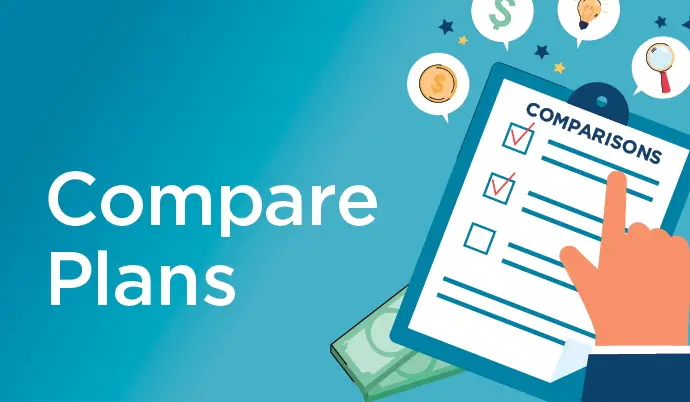Choosing the right health insurance plan is one of the most important decisions you can make for your financial and physical well-being. Health care costs can be high, and the right insurance policy helps you get the care you need while protecting you from financial hardship. But with so many options, comparing health insurance plans can be confusing. This in-depth guide walks you through how to compare health insurance plans step by step, ensuring you make an informed, confident decision.
What Is Health Insurance?
Health insurance is a contract where you pay a monthly premium to a provider in exchange for coverage of medical expenses. These can include doctor visits, hospital stays, prescription drugs, preventive care, and sometimes dental and vision. The goal is to protect you from high or unexpected health care costs.
Why Comparing Health Insurance Plans Matters
Not all health insurance plans are created equal. The costs, coverage, and networks can vary widely. Comparing plans allows you to:
- Get the best value for your money
- Avoid paying for unnecessary benefits
- Ensure your doctors and medications are covered
- Maximize your benefits for your specific health needs
Types of Health Insurance Plans
Before comparing plans, understand the major types available:
1. Health Maintenance Organization (HMO)
- Requires choosing a primary care physician (PCP)
- Referrals needed to see specialists
- Generally only covers care within the provider network
- Lower premiums and out-of-pocket costs
2. Preferred Provider Organization (PPO)
- No PCP requirement
- Can see specialists without a referral
- Covers in- and out-of-network care (but at different rates)
- Higher premiums, but more flexibility
3. Exclusive Provider Organization (EPO)
- No PCP or referrals needed
- Only covers care from in-network providers
- Lower costs than PPOs but less flexibility
4. Point of Service (POS)
- Combines features of HMO and PPO
- Requires a PCP and referrals for specialists
- Covers out-of-network care at a higher cost
5. High Deductible Health Plan (HDHP) with HSA
- Higher deductible and out-of-pocket maximum
- Often lower premiums
- Eligible for Health Savings Account (HSA) contributions
Key Factors to Compare in Health Insurance Plans
When comparing health insurance, focus on both cost and coverage. Here’s a detailed breakdown:
1. Monthly Premium
- The fixed amount you pay every month for your plan.
- Lower premiums may mean higher deductibles and out-of-pocket costs.
2. Deductible
- The amount you must pay before insurance starts to cover services.
- Some plans have separate deductibles for prescriptions and general care.
3. Co-Payments and Co-Insurance
- Co-Payment: A flat fee (e.g., $20) for services like doctor visits.
- Co-Insurance: A percentage (e.g., 20%) of the cost you pay after meeting your deductible.
4. Out-of-Pocket Maximum
- The most you’ll pay in a year for covered services.
- After reaching this amount, your insurance pays 100% of covered services.
5. Network of Providers
- Check if your doctors, hospitals, and specialists are in-network.
- Out-of-network care is usually more expensive or not covered at all.
6. Prescription Drug Coverage
- Review the plan’s formulary (list of covered medications).
- Check tiers, co-pays, and whether prior authorization is required.
7. Covered Services
- Confirm coverage for:
- Preventive care
- Maternity and newborn care
- Mental health and substance abuse services
- Emergency services
- Laboratory tests and imaging
8. Special Features and Add-ons
- Some plans offer telehealth, wellness programs, dental, and vision.
- Evaluate their value and relevance to your health needs.
Step-by-Step Process to Compare Health Insurance Plans
Step 1: Evaluate Your Health Needs
- How often do you visit doctors?
- Do you have chronic conditions or take prescription medication?
- Are you planning major health events (e.g., pregnancy, surgery)?
Step 2: Estimate Annual Costs
Add up:
- Premiums
- Deductible
- Co-pays and co-insurance
- Likely out-of-pocket costs based on your health history
Step 3: Compare Plan Documents (Summary of Benefits and Coverage)
These summaries provide a side-by-side comparison of services, costs, and coverage.
Step 4: Check Network Providers
Use the insurer’s online directory or call customer service to confirm that your current providers are in-network.
Step 5: Review Drug Formulary
Make sure your medications are covered and check the cost-sharing levels for each.
Step 6: Look at Quality Ratings
Sites like Healthcare.gov and NCQA.org rate insurance plans on customer service, care quality, and member satisfaction.
Step 7: Ask Questions
- Is a referral needed for specialists?
- Are pre-existing conditions covered?
- How are emergencies handled, especially out-of-network?
Where to Compare Health Insurance Plans
- Healthcare.gov (federal marketplace)
- State exchanges (if your state has one)
- Private insurance companies’ websites
- Brokers and agents
- Comparison websites like Policygenius or eHealthInsurance
Understanding Marketplace Metal Tiers (Bronze, Silver, Gold, Platinum)
Each tier represents a different balance of premiums and out-of-pocket costs:
- Bronze: Lowest premiums, highest costs when you need care
- Silver: Moderate premiums and costs; eligible for cost-sharing reductions
- Gold: Higher premiums, lower out-of-pocket costs
- Platinum: Highest premiums, lowest costs when receiving care
Choose based on your expected healthcare usage and budget.
Health Insurance for Special Groups
- Young Adults: May stay on a parent’s plan until age 26 or choose a catastrophic plan
- Seniors: Compare Medicare plans
- Low-Income Individuals: May qualify for Medicaid or subsidies on the marketplace
- Self-Employed or Freelancers: Look into individual plans or group associations
Mistakes to Avoid When Comparing Plans
- Choosing Based on Premium Alone: This may result in higher total costs
- Not Checking the Provider Network: You may lose access to your preferred doctors
- Ignoring Drug Coverage: Can lead to expensive medication costs
- Skipping the Fine Print: Understand coverage limits, exclusions, and claim procedures
Tips to Save on Health Insurance
- Use Preventive Services: Most are covered for free under ACA-compliant plans
- Stay In-Network: Avoid extra costs
- Use Generic Drugs: They’re usually much cheaper than brand-name
- Track Medical Expenses: Helps in choosing the right plan next year
- Open an HSA: If you have a high-deductible plan, HSAs offer tax advantages
When Can You Enroll or Switch Plans?
- Open Enrollment: Usually runs from November to mid-January (dates vary by state)
- Special Enrollment: Triggered by life events such as marriage, birth, or job loss
Missing the enrollment window could limit your options.
Final Thoughts
Comparing health insurance plans is not just about picking the cheapest option—it’s about finding the best plan for your medical needs and financial situation. The right plan provides peace of mind, helps manage healthcare expenses, and ensures you get timely access to quality care.
Take the time to review all aspects of each plan, from costs and provider networks to drug coverage and benefits. Use available tools and resources, ask questions, and consult professionals if needed.
Choosing wisely can make a huge difference in your health and your wallet.
If this article was informative also checkout: Auto Insurance Coverage




